6.2 The Evolution of Popular Music

The first stirrings of popular or pop music—any music genre that appeals to a broad audience or subculture—began in the late 19th century, with discoveries by Thomas Edison and Emile Berliner. In 1877, Edison discovered that he could reproduce sound using a strip of tinfoil wrapped around a rotating metal cylinder. Edison’s phonograph provided ideas and inspiration for Berliner’s gramophone, which used flat discs to record sound. The flat discs offered several advantages over the cylinders, enabling the mass production of sound recordings. This would have a significant impact on the popular music industry. Members of the middle class could now purchase technology that was previously available exclusively to an elite few. Berliner founded the Berliner Gramophone Company to manufacture his discs, and he encouraged popular operatic singers such as Enrico Caruso and Dame Nellie Melba to record their music using his system. Opera singers had enormous clout during the 19th century, and their music generated the most sheet music sales in the United States. Although the gramophone promised an exciting new development, disc recordings would take 20 years to rival sheet music in commercial importance (Shepherd, 2003).
In the late 19th century, the United States strengthened its lax copyright laws, which provided an opportunity for composers, singers, and publishers to collaborate and earn money by producing a large volume of music. Numerous publishers began to emerge in an area of New York that became known as Tin Pan Alley. Allegedly named because the cacophony of many pianos played simultaneously in the publishers’ demo rooms sounded like people pounding on tin pans, Tin Pan Alley soon became a prolific source of popular music, with its publishers mass-producing sheet music to satisfy the demands of a growing middle class. Whereas audiences exalted classical artists for their individuality and expected them to differ stylistically from other classical artists, popular artists garnered acclaim for conforming to the tastes of their intended audience. Popular genres expanded from opera to include vaudeville—a form of variety entertainment containing short acts featuring singers, dancers, magicians, and comedians that opened new doors for publishers to sell songs popularized by the live shows—and ragtime, a style of piano music characterized by a syncopated melody.
The Tin Pan Alley tradition of song publishing continued throughout the first half of the 20th century, with the show tunes and soothing ballads of Irving Berlin, Cole Porter, and George Gershwin, as well as the songwriting teams of the early 1950s, such as Jerry Leiber and Mike Stoller. By hiring songwriters to compose music based on public demand and mainstream tastes, the Tin Pan Alley publishers introduced the concept of popular music as we know it.
The Roaring 1920s: Radio versus Records
In the 1920s, Tin Pan Alley’s dominance of the popular music industry faced threats from two technological developments: the advent of electrical recording and the rapid growth of radio.
During the early days of its development, people viewed the gramophone as a scientific novelty that posed little threat to sheet music because of its poor sound quality. However, as inventors improved various aspects of the device, the sales of gramophone records began to affect sheet music sales. The Copyright Act of 1911 had imposed a royalty on all records of copyrighted musical works to compensate for the loss in revenue to composers and authors. This loss became even more prominent during the mid-1920s, when improvements in electrical recording drastically increased sales of gramophones and gramophone records. The greater range and sensitivity of the electrical broadcasting microphone revolutionized gramophone recording to such an extent that sales of sheet music plummeted. From the very beginning, the record industry faced challenges from new technology.
Composers and publishers could deal with the losses caused by an increase in gramophone sales because of the provisions made in the Copyright Act. However, when radio broadcasting emerged in the early 1920s, both gramophone sales and sheet music sales began to suffer. Radio, as a medium, enabled listeners to experience events as they unfolded at an affordable price. Better yet, it offered a wide range of free music that required none of the musical skills, expensive instruments, or sheet music necessary for creating one’s music at home, nor the expense of purchasing records to play on the gramophone. This development threatened the entire recording industry, which ultimately earned the right to collect license fees from broadcasters. With the license fees in place, the recording industry eventually began to profit from the new technology.
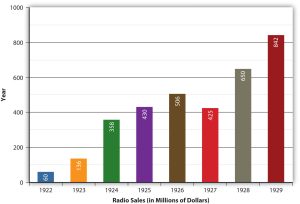
The 1930s: The Rise of Jazz and Blues
The ascendance of Tin Pan Alley coincided with the emergence of jazz in New Orleans. An improvisational form of music primarily driven by instrumentals, jazz incorporates a variety of styles, including African rhythms, gospel, and blues. Established by New Orleans musicians such as King Oliver and his protégé, Louis Armstrong, who many rank as one of the most outstanding jazz soloists in history, jazz spread along the Mississippi River by the bands that traveled up and down the river playing on steamboats. During the Prohibition era in the 1920s and early 1930s, some jazz bands played in illegal speakeasies, which helped generate the genre’s reputation as immoral and threatening to the country’s cultural values. However, jazz became a legitimate form of entertainment during the 1930s, when orchestras with White musicians began to incorporate jazz style into their music. During this time, jazz music began to adopt a big band style, combining elements of ragtime, Black spirituals, blues, and European music. Key figures in developing the big jazz band included bandleaders Duke Ellington, Coleman Hawkins, and Glenn Miller. These big band orchestras used an arranger to limit improvisation by assigning parts of a piece of music to various band members. Although musicians could still improvise during solo performances, the format became more structured, leading to the emergence of the swing style of jazz that became popular in the 1930s. As the decade progressed, social attitudes toward racial segregation relaxed, and big bands became more racially integrated.
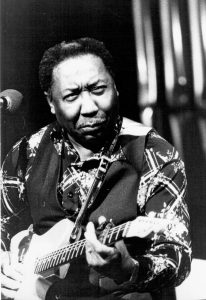
Former enslaved Africans and their descendants adapted their musical heritage and infused it with jazz to create the blues. Dealing with themes of personal adversity, overcoming hard luck, and other emotional turmoil, the blues utilizes a 12-bar musical form with a call-and-response format between the singer and his guitar. Originating in the Mississippi Delta, just upriver from New Orleans, blues music gained influence through the music stylings of W. C. Handy, Ma Rainey, Robert Johnson, and Lead Belly, among others. Unlike jazz, the blues did not spread significantly to the Northern states until the late 1930s and 1940s. Once Southern migrants introduced the blues to urban Northern cities, the music developed into distinctive regional styles, ranging from the jazz-oriented Kansas City blues to the swing-based West Coast blues. Chicago blues musicians, such as Muddy Waters, are credited with being the first to electrify the blues through the use of electric guitars and to blend urban style with classic Southern blues. The electric guitar, first produced by Adolph Rickenbacker in 1931, changed music by intensifying the sound and creating a louder volume that could cut through noise in bars and nightclubs (Rickenbacker, 2010). By focusing less on shouting, singers can convey more emotion and intimacy in their performances. This electrified form of blues provided the foundations of rock and roll.
The golden age of radio started in the 1920s and lasted through the 1950s. During this period, the number of licensed radio stations in the United States increased dramatically, from five in 1921 to over 600 by 1925 (Salmon, 2010). The introduction of radio broadcasting provided a valuable link between urban city centers and small, rural towns. Able to transmit music nationwide, rural radio stations broadcast local music genres that soon gained popularity across the country.
The 1940s: Technology Progresses
Technological advances during the 1940s made it even easier for people to listen to their favorite music and for artists to record it. The introduction of the reel-to-reel tape recorder paved the way for several innovations that would transform the music industry. The first commercially available tape recorders were monophonic, meaning they had only one track on which to record sound onto magnetic tape. This may seem limiting today, but at the time, it allowed for exciting innovations. During the 1940s and 1950s, some musicians—most notably guitarist Les Paul, with his song “Lover (When You’re Near Me)”—began to experiment with overdubbing, in which they played back a previously recorded tape through a mixer, blended it with a live performance, and recorded the composite signal onto a second tape recorder. By the time four-track and eight-track recorders became readily available in the 1960s, musicians no longer had to play together in the same room; they could record each part separately and combine them into a finished recording.

Families listening to music at home would also notice innovations in sound technology. The recording industry had produced discs that rotated at 78 revolutions per minute (rpm) for many years despite the necessity of changing the disc every five minutes. In 1948, Columbia Records perfected the 12-inch 33 rpm long-playing (LP) disc, which could play up to 25 minutes per side and had a lower level of surface noise than the earlier (and highly breakable) shellac discs (Lomax, 2003). The 33 rpm discs became the standard form for full albums and would dominate the recorded music industry until the advent of the compact disc (CD).
During the 1940s, a mutually beneficial alliance existed between sound recording and radio. Artists such as Frank Sinatra and Ella Fitzgerald profited from radio exposure. Until this time, the industry primarily provided music that appealed to adults, but the popularity of Sinatra and his contemporaries revealed an entirely untapped market: teenagers. The postwar boom of the 1940s offered many teenagers the spending money to buy records. Radio airplay helped to promote and sell records and the recording artists themselves, which in turn stabilized the recording industry. The near riots caused by the appearance of New Jersey crooner Frank Sinatra in concert paved the way for mass hysteria among Elvis Presley and Beatles fans during the rock and roll era.
The 1950s: The Advent of Rock and Roll
New technology continued to develop in the 1950s with the introduction of television. The new medium spread rapidly, primarily due to cheaper mass-production costs and technological advancements resulting from the war. In 1948, only 1 percent of America’s households owned a television; by 1953, this figure had risen to nearly 50 percent, and by 1978, almost every home in the United States owned a television (Genova). The introduction of television into people’s homes threatened the existence of the radio industry. The radio industry adapted by focusing on music, forming alliances with the recording industry to ensure its survival. To do so, it became a somewhat promotional tool. Stations became increasingly dependent on recorded music to fill airtime, and in 1955, the Top 40 format made its debut. Radio stations would generate playlists based on popularity (referencing the Billboard Top 40 singles chart), and a popular song might get played as many as 30 or 40 times a day. Radio stations began to influence record sales, leading to increased competition for spots on their playlists. This ultimately resulted in payola—the illegal practice of receiving payment from a record company for broadcasting a particular song on the radio. The payola scandal came to a head in the 1960s when the government accused DJ Alan Freed and eight other disc jockeys of accepting money in exchange for airplay. Following Freed’s trial, the U.S. passed an antipayola statute, making payola a misdemeanor crime.
As technologies evolved, so too did music during the 1950s. The urban Chicago blues, typified by artists such as Muddy Waters, Howlin’ Wolf, and B.B. King, surged in popularity among both White and Black teenagers. Marketed under the name rhythm and blues, or R&B, the sexually suggestive lyrics in songs such as “Sexy Ways” and “Sixty Minute Man” and the electrified guitar and wailing harmonica sounds appealed to young listeners. At the time, the industry classified R&B records as “race music,” and they segregated their sales from the White music records tracked on the pop charts (Szatmary, 2010). Nonetheless, a considerable amount of crossover existed among audiences. In 1952, the Dolphins of Hollywood record store in Los Angeles, which specialized in R&B music, noted that 40 percent of its sales went to White individuals (Szatmary, 2010).
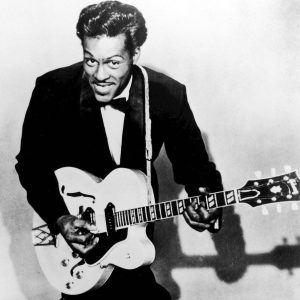
Although banned from some stations, others embraced the popular new music. In 1951, Freed started a late-night R&B show called The Moondog Rock & Roll House Party and began referring to the music he played as rock and roll (History Of Rock). Taking its name from a blues slang term for sex, the music obtained instant notoriety, gaining widespread support among teenage music fans and widespread dislike among the older generation (History Of Rock). Frenetic showmen Little Richard and Chuck Berry pioneered early rock and roll, and their wild stage performances became characteristic of the genre.
While primarily known for his original rock and roll compositions, Chuck Berry, like many artists of his era, sometimes incorporated existing musical forms into his repertoire. In particular, he would occasionally cover “hillbilly” or country songs, infusing them with his signature rock and roll energy. This practice was not uncommon during a time when genre lines were still somewhat fluid, and artists often drew inspiration from various American musical traditions. By taking these country-flavored tunes and injecting them with his rhythm and blues sensibility, Berry further cemented the interconnectedness of different musical styles that would eventually converge to form the diverse landscape of popular music we know today. His ability to adapt and transform these influences into something entirely new solidified his status as a true pioneer and a foundational architect of rock and roll. As the integration of White and Black individuals progressed in the 1950s with the repeal of segregation laws and the initiation of the civil rights movement, aspects of Black culture, including music, became more widely accepted by many White individuals.
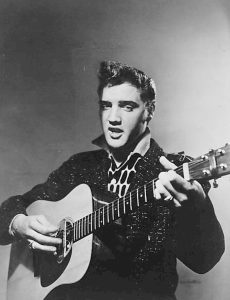
However, the introduction of a White man who sang songs written by Black musicians helped rock and roll spread across state and racial lines. Elvis Presley, a singer and guitarist, the “King of Rock and Roll,” further helped make music written by Black individuals acceptable to mainstream White audiences and also helped popularize rockabilly—a blend of rock and country music—with Black audiences during the mid-1950s. Heavily influenced by his rural Southern roots, Presley combined the R&B music of bluesmen B. B. King, John Lee Hooker, and Howlin’ Wolf with the country-western tradition of Roy Acuff, Ernest Tubb, and Jimmie Rodgers, and added a touch of gospel (Elvis). The reaction Presley inspired among hordes of adolescent girls—screaming, crying, rioting—solidified his reputation as the first authentic rock and roll icon.
The 1960s: Rock and Roll Branches Out From R&B
Before 1964, rock and roll was primarily composed of American acts. Although U.S. artists frequently reached the top of the charts overseas, few European artists achieved success on this side of the Atlantic. This situation changed almost overnight with the arrival of British pop phenomenon the Beatles. Combining elements of skiffle—a type of music played on rudimentary instruments, such as banjos, guitars, or homemade instruments—doo-wop, and soul, the four mop-haired musicians from Liverpool, England, created a genre of music known as Merseybeat, named after the River Mersey. The Beatles’ genial personalities and catchy pop tunes made them an instant success in the United States, and their popularity heightened with several appearances on The Ed Sullivan Show. When the Beatles arrived in New York in 1964, hundreds of reporters, police officers, and thousands of fans met them at the airport. Their appearance on The Ed Sullivan Show a few days later resulted in the largest audience for an American television program, with approximately one in three Americans (74 million) tuning in (Gould, 2007). Beatlemania—the term coined to describe fans’ wildly enthusiastic reaction to the band—extended to other British bands, and by the mid-1960s, the Kinks, the Zombies, the Animals, Herman’s Hermits, the Who, and the Rolling Stones all had made appearances on the U.S. charts. The Rolling Stones’ urban rock sound steered away from pop music and remained more true to the bluesy, R&B roots of rock and roll. The British Invasion transformed rock and roll into the all-encompassing genre of rock, sending future performers in two different directions: the melodic, poppy sounds of the Beatles, on the one hand, and the gritty, high-volume power rock of the Stones, on the other.
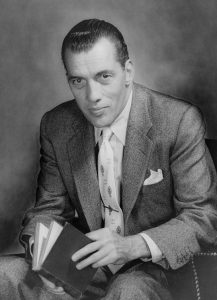
The branching out of rock and roll continued in several other directions throughout the 1960s. Surf music, embodied by artists such as the Beach Boys, Jan and Dean, and Dick Dale, celebrated the aspects of youth culture in California. With their twanging electric guitars and glossy harmonies, the surf groups sang of girls, beaches, and convertible cars cruising along the West Coast. In Detroit, some Black performers developed a sound that would have crossover appeal with both Black and White audiences. Combining R&B, pop, gospel, and blues into a genre known as soul, vocalists such as James Brown, Aretha Franklin, Otis Redding, and Wilson Pickett sang about the lives of Black Americans. Producer and songwriter Berry Gordy Jr. developed soul music through the creation of his Motown label, which would become one of the most successful businesses owned by a Black individual in American history (Notable Biographies). Capitalizing on the 1960s girl-group craze, Gordy produced hits by the Marvelettes, Martha and the Vandellas, and, most successfully, Diana Ross and the Supremes. For his bands, he created a slick, polished image designed to appeal to the American mainstream.
In the late 1960s, supporters of the civil rights movement, along with feminists, environmentalists, and Vietnam War protesters, gravitated toward folk music, which would become the soundtrack of social activism. Broadly referring to music passed down orally through generations, folk music retained an unpolished, amateur quality that inspired participation and social awareness. Carrying on the legacy of the 1930s labor activist Woody Guthrie, singer-songwriters such as Joan Baez, Peter, Paul, and Mary, and Bob Dylan sang social protest songs about civil rights, discrimination against Black Americans, and the Cuban Missile Crisis. Having earned himself a reputation as a political spokesperson, Dylan found himself lambasted by traditional folk fans for playing an electric guitar at the 1965 Newport Folk Festival. However, his attempt to reach a broader crowd inspired the folk rock genre, pioneered by the Los Angeles band the Byrds (PBS). Even though many fans questioned his decision to go electric, Dylan’s poetic and politically charged lyrics influenced future artists, inspiring groups like the Beatles and the Animals. Protest music in the 1960s became closely aligned with the hippie culture, in which some viewed taking drugs as a form of personal expression and free speech. Artists such as Jimi Hendrix, Jefferson Airplane, the Grateful Dead, and the Doors believed that mind-altering drugs could enhance the music listening experience (Rounds, 2007). This spirit of freedom and protest culminated in the infamous Woodstock festival in the summer of 1969. However, the subsequent deaths of many of its stars from drug overdoses cast a shadow over the psychedelic culture.
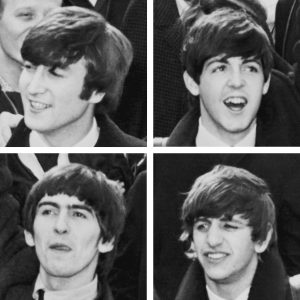
From Stage to Sgt. Pepper’s: The Beatles’ Recording Revolution
The Beatles stand as an unparalleled phenomenon in the history of popular music, fundamentally altering its trajectory in the 1960s. While their electrifying live performances initially propelled their fame, it was their groundbreaking approach to recorded music that truly cemented their legacy. Unlike many artists who viewed recordings primarily as a means to promote live shows, The Beatles began to see the studio as an instrument in itself, a place where they could craft intricate sonic landscapes impossible to replicate on stage. Early in their career, their live concerts were often overwhelmed by the sheer enthusiasm of “screaming girls,” a testament to their unparalleled charisma and the burgeoning Beatlemania. This intense fan reaction, while exhilarating, eventually made live performance creatively stifling, prompting the band to focus more intently on studio innovation.
This shift in focus culminated in the creation of the concept album, a revolutionary idea that transformed how albums were perceived. Before this, LPs were often collections of disparate singles and filler tracks. A concept album, however, presents a unified artistic statement, a group of related songs that explore common themes, narratives, or moods, designed to be listened to as a cohesive work rather than individual tracks. This innovative format allowed artists to delve deeper into complex ideas and expand the storytelling capabilities of popular music.
The album widely credited as the first true concept album is The Beatles’ 1967 masterpiece, Sgt. Pepper’s Lonely Hearts Club Band. Pepper’s Lonely Hearts Club Band. From its iconic cover art to its meticulously arranged tracks, Sgt. Pepper’s was explicitly designed to be played from beginning to end, with seamless transitions and recurring motifs creating an immersive auditory experience. Its diverse musical styles, experimental production techniques, and often philosophical lyrics showcased the band’s unparalleled creative ambition—the immense critical and commercial success of Sgt. Pepper’s Lonely Hearts Club Band. Pepper’s Lonely Hearts Club Band dramatically elevated the album’s status, firmly establishing the LP as the primary format in rock music, effectively replacing the single as the primary artistic statement and commercial vehicle for many artists. This pivot encouraged a new era of creative freedom and innovation, inspiring countless musicians to explore the album format as a canvas for their most ambitious and interconnected musical visions.
The 1970s: From Glam Rock to Punk
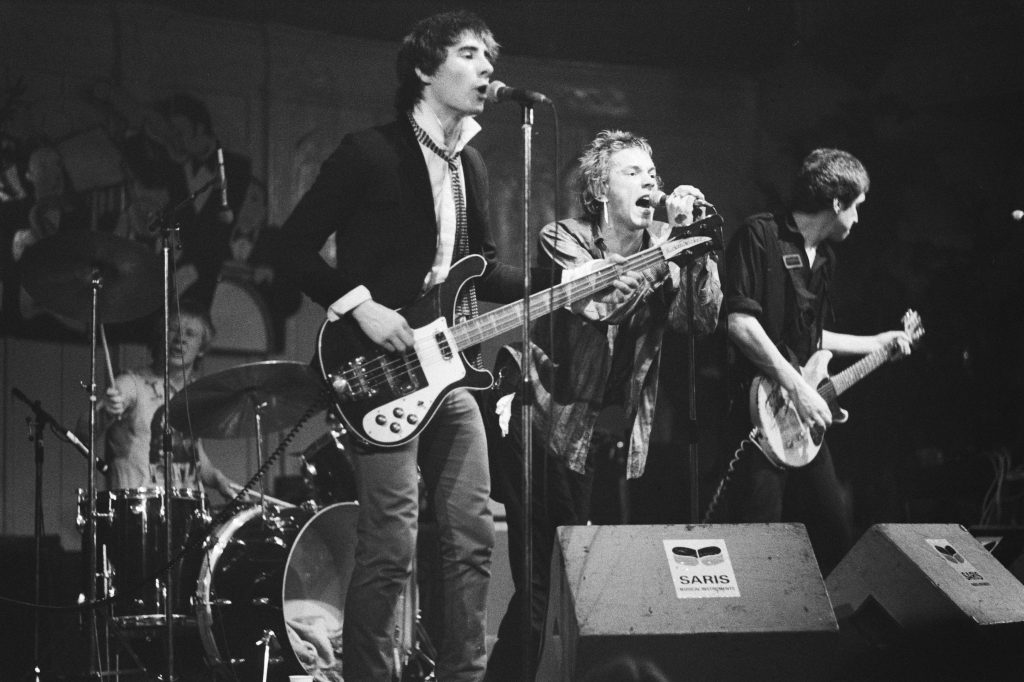
After the Vietnam War ended, college students began to settle down and focus on careers and families. For some, selfish views took the place of concern with social issues and political activism, causing writer Tom Wolfe to label the 1970s the “me” decade (Wolfe, 1976). Musically, this ideological shift gave rise to glam rock, an extravagant and self-indulgent form of rock that incorporated flamboyant costumes, heavy makeup, and elements of hard rock and pop. A primarily British phenomenon, glam rock acts such as Slade, David Bowie, the Sweet, Elton John, and Gary Glitter popularized the genre. It served as a precursor for the punk movement in the late 1970s. Equally flamboyant, but emerging from a more electronic sound, disco also gained popularity in the 1970s. Popular disco artists included KC and the Sunshine Band, Gloria Gaynor, the Bee Gees, and Donna Summer, who helped to pioneer its electronic sound. Boosted by the success of the 1977 film Saturday Night Fever, disco’s popularity spread across the country as record companies churned out tunes that became massive hits on the dance floor.
Reacting against the commercialism of disco and corporate rock, punk artists created a minimalist, angry form of rock that returned to the basics of rock and roll: simple chord structures, catchy tunes, and politically motivated lyrics. Like the skiffle bands of the 1950s, some found punk rock appealing because anyone with basic musical skills could participate. The punk rock movement emerged out of CBGB, a small bar in New York City that featured bands such as Television, Blondie, and the Ramones. Never a huge commercial success in the United States, punk rock gained popularity in the United Kingdom, where high unemployment rates and class divisions had created an angry, disenfranchised youth population (BBC). The Sex Pistols, fronted by Johnny Rotten, developed an aggressive, pumping sound that appealed to a rebellious generation of listeners, although many critics disparaged the band at the time. In 1976, British music paper Melody Maker complained that “the Sex Pistols do as much for music as World War II did for the cause of peace (Gray, 2001).” Punk bands began to abandon their sound in the late 1970s, when the punk style was assimilated into the mainstream of rock.
The 1980s: The Hip-Hop Generation
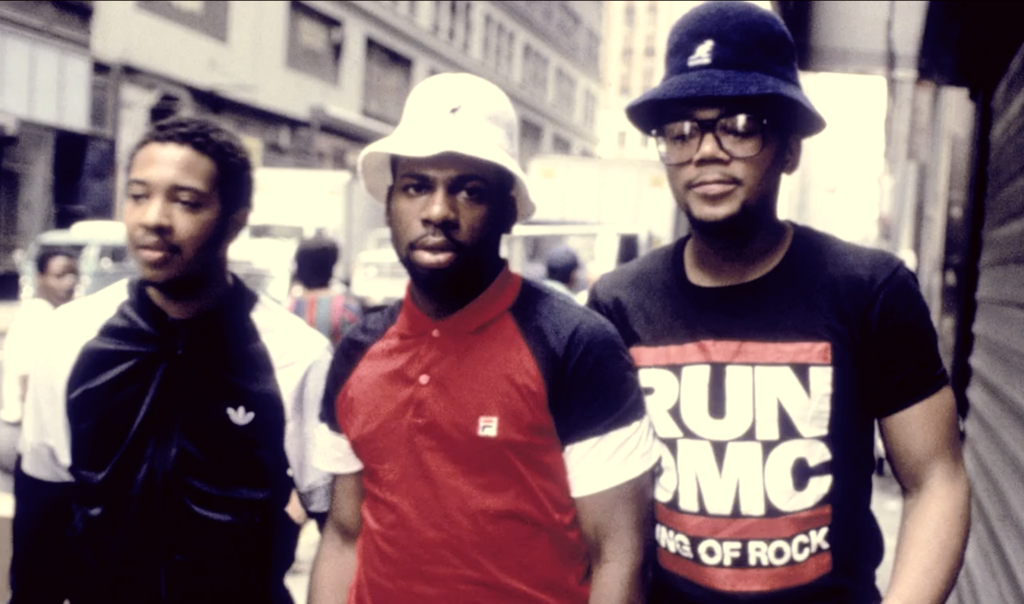
Whereas many British youths expressed their displeasure through punk music, many disenfranchised Black American youths in the 1980s turned to hip-hop. This term encompasses the urban culture of break dancing, graffiti art, and the musical techniques of rapping, sampling, and scratching records. Reacting against the extravagance of disco, many poor urban rappers developed their own street culture by adopting a casual image consisting of T-shirts and sportswear, creating a language that reflected the everyday concerns of people in low-income urban areas, and by embracing the low-budget visual art form of graffiti. They described their new culture as hip-hop, after a common phrase chanted at dance parties in New York’s Bronx borough.
The hip-hop genre first became popular among Black youths in the late 1970s, when record spinners in the Bronx and Harlem started to play short fragments of songs rather than the entire track (known as sampling) (Demers, 2003). Early hip-hop artists sampled a wide range of music, including funk, soul, and jazz, later adding special effects to the samples and experimenting with techniques such as rotating or scratching records back and forth to create a rhythmic pattern. For example, Kool Moe Dee’s track “How Ya Like Me Now” includes samples from James Brown’s classic funk song “Papa’s Got a Brand New Bag.” The DJs would often add short raps to their music to let audiences know who played the records, a trend that grew more elaborate over time to include entire spoken verses. Artists such as Grandmaster Flash and the Furious Five incorporated political and social commentary on the realities of life in low-income, high-crime areas—a trend that would continue with later rappers, including Public Enemy and Ice-T.
In the early 1980s, a second wave of rap artists introduced inner-city rap to American youths by blending it with the hard rock guitar sound. Pioneered by groups such as Run-D.M.C. and the Beastie Boys, the new music appealed to both Black and White audiences. A controversial subgenre of hip-hop, epitomized by West Coast rappers such as Ice Cube and Tupac Shakur, called gangsta rap, emerged on the scene. Highlighting violence and gang warfare, gangsta rappers faced accusations that they created violence in inner cities—an argument that gained momentum with the East Coast–West Coast rivalry of the 1990s.
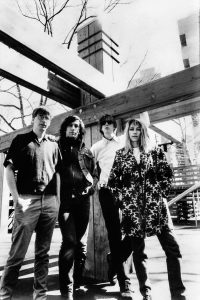
Beyond the Big Hair: Unearthing the ’80s Indie Underground
Think you know the ’80s sound? Did it sound like synthesizer-driven pop anthems and hair-band power ballads, or was it more aligned with the raw energy of punk rock and the emerging sounds of hip-hop? While mainstream airwaves of the 1980s were dominated by glossy pop, new wave, and arena rock, beneath the surface, America’s underground music scene was fiercely brewing. This vibrant, often rebellious, counterculture fostered a diverse array of sounds that deliberately stood apart from the commercial giants.
One of the most comprehensive and influential accounts of this pivotal era is Michael Azerrad‘s 2001 book, Our Band Could Be Your Life: Scenes from the American Indie Underground 1981-1991. Azerrad’s work meticulously chronicles the struggles, triumphs, and unique philosophies of thirteen seminal bands that defined the 1980s indie scene, capturing their DIY ethos and the often arduous realities of life on the road. The book delves into the individual stories of these groups, highlighting their regional differences, musical innovations, and the interconnected community they built largely outside the mainstream music industry.
Among the bands featured are Black Flag, pioneers of Southern California hardcore and a blueprint for independent touring; Minutemen, known for their unique blend of punk, funk, and jazz; Boston’s post-punk innovators Mission of Burma; Washington D.C.’s straight edge flagbearers Minor Threat; Minneapolis’s melodic punk trailblazers Hüsker Dü and the notoriously chaotic The Replacements; New York’s experimental noise-rockers Sonic Youth; the irreverent and challenging Butthole Surfers; the abrasive and influential Big Black; the melodic and impactful Dinosaur Jr.; the fiercely independent and ethical Fugazi; Seattle’s grunge progenitors Mudhoney; and Olympia, Washington’s twee-pop pioneers Beat Happening. Our Band Could Be Your Life paints a vivid picture of a time when passion, artistic integrity, and a fierce commitment to independence often took precedence over commercial success, laying the essential groundwork for the alternative music boom of the 1990s.
The Launch of MTV
The launch of MTV on August 1, 1981, marked a revolutionary moment in media history, fundamentally reshaping not only the music industry but also youth culture itself. By blending music with visual storytelling, MTV transformed songs into immersive experiences, creating global superstars and influencing fashion, dance, and social trends. For a generation of young viewers, MTV became a primary source of entertainment and a powerful arbiter of cool, offering a constant stream of music videos, VJs (video jockeys), and special programming that spoke directly to their interests and aspirations. The channel’s pervasive presence in homes allowed for an unprecedented level of visual access to artists and their carefully crafted images, establishing a new paradigm where visual presentation became as crucial as audio quality in defining an artist’s appeal and marketability.
However, MTV’s profound influence was not without its controversies, particularly concerning the content of the music videos it aired. Over time, critics observed a significant increase in sexually suggestive and violent imagery within these visual narratives. Studies and analyses, including some estimating that anywhere from 40 to 75 percent of music videos contain sexual imagery, fueled concerns about the potential impact on impressionable young viewers. A particularly persistent criticism focused on the portrayal of violence against women, with arguments suggesting that repeated exposure to such imagery, often glamorized or normalized within a popular cultural context, could lead to desensitization. Critics worried that this desensitization might diminish empathy and reinforce harmful stereotypes, contributing to a broader societal acceptance of violence against women. These debates highlighted the complex relationship between media content, youth development, and societal values, underscoring the powerful role MTV played in shaping perceptions and behaviors during its peak influence.
The 1990s: New Developments in Hip-Hop, Rock, and Pop
Hip-hop and gangsta rap maintained their popularity in the early 1990s with artists such as Tupac Shakur, the Notorious B.I.G., Dr. Dre, Eazy-E, Ice Cube, and Snoop Dogg at the top of the charts. West Coast rappers, such as Tupac Shakur and Snoop Dogg, favored gangsta rap, while East Coast rappers, like the Notorious B.I.G. and Sean Combs, adhered to a traditional hip-hop style. The rivalry culminated with the murders of Shakur in 1996 and B.I.G. in 1997.

Along with hip-hop and gangsta rap, alternative rock emerged as a prominent genre in the 1990s, spearheaded by the grunge movement. The grunge scene appeared in the mid-1980s in the Seattle area of Washington State. Inspired by hardcore punk and heavy metal, this subgenre of rock earned its moniker due to its messy, sludgy, and distorted guitar sound, the disheveled appearance of its pioneers, and the disaffected nature of its artists. Initially achieving limited success with Seattle bands Soundgarden and Mudhoney, the Seattle independent label Sub Pop gained more prominence when it signed another local band, Nirvana. Fronted by vocalist and guitarist Kurt Cobain, Nirvana came to be identified with Generation X—the post–baby boom generation, many of whom came from broken families and experienced violence both on television and in real life. Nirvana’s angst-filled lyrics spoke to many members of Generation X, launching the band into the mainstream. Ironically, Cobain felt uncomfortable and miserable, and he would eventually commit suicide in 1994. Nirvana’s success paved the way for other alternative rock bands, including Green Day, Pearl Jam, and Nine Inch Nails. Due to the ambiguous nature of the word “alternative,” the genre is fragmented into even more specific subgenres.
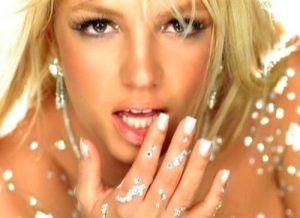
By the end of the 1990s, mainstream tastes leaned toward pop music. A plethora of boy bands, girl bands, and pop starlets emerged, sometimes evolving from gospel choir groups, but more often than not created by talent scouts. The groups were aggressively marketed to teen audiences. Popular bands included the Backstreet Boys, ’N Sync, and the Spice Girls. Meanwhile, individual pop acts from the MTV generation, such as Madonna, Michael Jackson, and Prince, continued to generate hits.
The 2000s: Pop Stays Strong as Hip-Hop Overtakes Rock in Popularity
The 2000s began right where the 1990s left off, with young singers such as Christina Aguilera and Destiny’s Child ruling the pop charts. Pop music remained strong throughout the decade, with artists such as Gwen Stefani, Mariah Carey, Beyoncé, Katy Perry, and Lady Gaga achieving mainstream success. By the end of the decade, country artists such as Carrie Underwood and Taylor Swift had transitioned from country stars to bona fide pop stars. While rock music started the decade strong, by the end of the 2000s, rock’s presence in mainstream music had waned, with a few exceptions such as Nickelback, Linkin Park, and Green Day.
Unlike rock music, hip-hop has maintained its popularity, with more commercially successful and polished artists, such as Kanye West, Jay-Z, Lupe Fiasco, and OutKast, achieving enormous success. While some gangsta rappers from the 1990s—like Dr. Dre and Snoop Dogg—softened their images, other rappers—such as 50 Cent and Eminem—continued to project a tough image and to use violent lyrics. An alternative style of hip-hop emerged in the 2000s that infused positive messages and an element of social conscience into the music that early hip-hop tracks lacked. Artists such as Common, Mos Def (now Yasiin Bey), and the Black Eyed Peas achieved success despite not conforming to traditional hip-hop stereotypes.
The 2010s: Streaming Reigns Supreme as Hip-Hop Diversifies and Pop Evolves
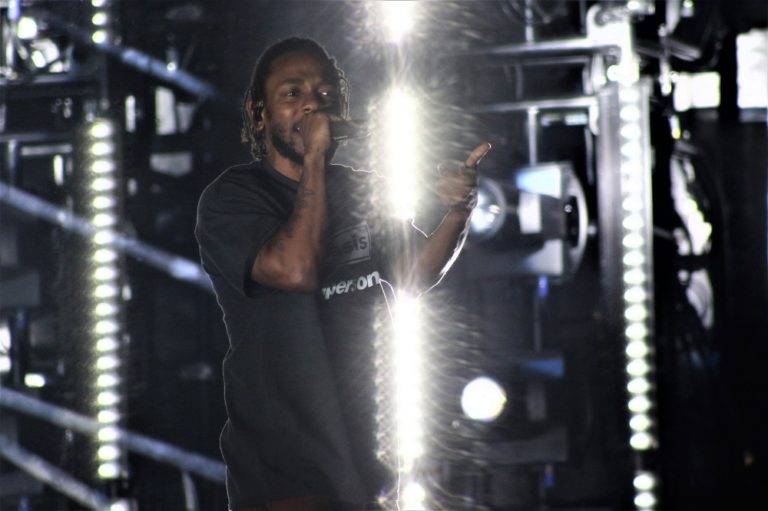
The 2010s were marked by a seismic shift to music streaming, which fundamentally altered consumption habits and democratized access to vast catalogs of music. Platforms like Spotify and Apple Music have become the dominant forces, enabling artists and listeners alike to achieve unprecedented global reach. Pop music continued to maintain its strong chart presence, evolving significantly to incorporate elements of electronic dance music (EDM) and a more globalized sound. Artists like Taylor Swift, Justin Bieber, Ariana Grande, and Ed Sheeran consistently topped the charts, showcasing a blend of traditional pop songwriting with contemporary production. The decade also saw the massive mainstream explosion of EDM, with producers such as Avicii, Calvin Harris, and David Guetta becoming household names and influencing pop music’s sonic landscape.
Hip-hop maintained and even solidified its position as a dominant genre, growing in diverse sub-genres and pushing lyrical boundaries. Artists like Kendrick Lamar, Drake, and J. Cole brought introspective lyrics and diverse production styles to the forefront. At the same time, subgenres such as “trap music,” “mumble rap,” and “emo hip-hop” gained significant traction. Collaborations across genres became increasingly common, blurring traditional lines and producing unexpected but successful fusions. The latter half of the decade also witnessed the significant global rise of K-pop, with groups like BTS breaking cultural and language barriers to achieve massive international success, signaling a new era of diverse global influences on the Western music market. Social media platforms, particularly Instagram and later TikTok, emerged as crucial tools for music discovery and promotion, further empowering artists and giving rise to viral hits.
The 2020s: TikTok, Genre Blurring, and the Nostalgia Cycle
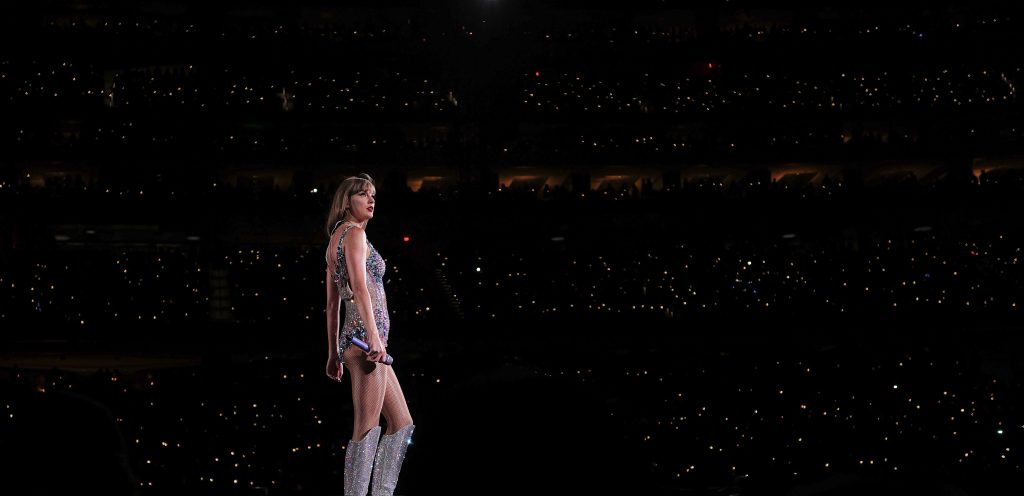
The 2020s have accelerated many of the trends from the previous decade, most notably the paramount influence of TikTok in music discovery and virality. A short, catchy snippet on the platform can propel an unknown artist to global fame overnight, leading to a new emphasis on “clipability” in songwriting. This has further fragmented the music landscape, with individual songs or even specific moments within songs gaining massive traction, sometimes overshadowing entire albums. Pop music remains a powerhouse, but a fluid, genre-bending approach increasingly characterizes it. Artists like Dua Lipa, Olivia Rodrigo, and Billie Eilish have spearheaded various pop revivals, from disco-infused dance-pop to pop-punk and indie-infused sounds, often channeling a “mad girl” aesthetic with raw, angrier expressions.
Hip-hop remains incredibly popular, but has experienced some stagnation in mainstream innovation compared to its explosive growth in the 2010s. However, vibrant underground scenes and new waves of female artists continue to emerge. Latin music, particularly reggaeton, continues its massive global expansion, achieving significant streaming numbers and infiltrating diverse genres. The 2020s have also been marked by a strong sense of nostalgia, with artists frequently drawing inspiration from the 1970s, 80s, and 90s. The Weeknd‘s ’80s synth-pop sound, for example, dominated charts and inspired a wave of similar retro-infused tracks. Country music has experienced a notable resurgence, with both traditional and genre-blending artists gaining immense mainstream popularity. Overall, the current decade is characterized by an unprecedented level of genre fluidity, rapid trend cycles driven by social media algorithms, and a constant reinterpretation of past musical eras, providing listeners with an incredibly diverse and constantly evolving auditory experience.

